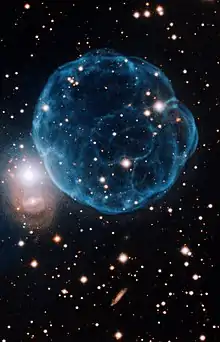| Emission nebula | |
|---|---|
| Planetary nebula | |
 Image of the Kronberger 61 nebula taken by the Gemini Observatory | |
| Observation data: J2000 epoch | |
| Right ascension | 19h 21m 38.936s[1] |
| Declination | +38° 18′ 57.2420″[1] |
| Apparent dimensions (V) | 1' 30" |
| Constellation | Cygnus |
| Designations | Kronberger 61, Soccer Ball Nebula[1] |
Kronberger 61, also known as the "soccer ball", is a planetary nebula discovered by an amateur astronomer in January, 2011, with the newer images having been taken by the Gemini Observatory.[2] The nebula is named for Austrian Mattias Kronberger,[3] who is a member of the amateur group Deep Sky Hunters. The object is estimated to lie 13,000 light-years away. They discovered the nebula while searching near the northern constellation of Cygnus.[4] It is hoped that the discovery will help resolve a decades-old debate, regarding the role of stellar companions in the formation and structure of planetary nebulae.[5]
The nebula is within a relatively small area, which is currently being monitored by NASA's Kepler planet finding mission and the light of the nebula is primarily due to the emissions from doubly ionized oxygen.[5]
See also
- IRAS 19475+3119, protoplanetary nebula of Cygnus
- List of largest nebulae
References
- 1 2 3 "NAME Soccer Ball Nebula". SIMBAD. Centre de données astronomiques de Strasbourg. Retrieved 30 August 2015.
- ↑ Mosher, Dave. "'Soccer Ball' Nebula Discovered by Amateur Astronomer". National Geographic. Archived from the original on October 20, 2012.
- ↑ "Österreichischer Hobby-Astronom entdeckt prachtvollen Planetarischen Nebel". DER STANDARD (in Austrian German). Retrieved 2023-06-14.
- ↑ Moore, Kurt (July 28, 2011). "New Planetary Nebula Found By Amateur Astronomer". KRIV (TV). Archived from the original on April 5, 2012.
- 1 2 Jacoby, George (8 August 2011). "Gemini Observatory Image Release". Gemini Observatory.


.jpg.webp)